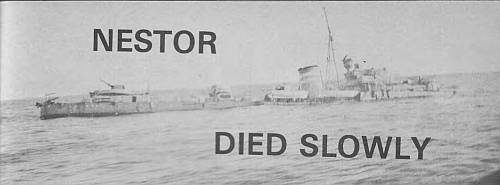- Author
- Lind, L.J. and Payne, Alan
- Subjects
- History - general, Ship histories and stories, WWII operations
- Tags
-
- RAN Ships
- HMAS Warramunga I, HMAS Napier, HMAS Nestor, HMAS Nizam
- Publication
- December 1972 edition of the Naval Historical Review (all rights reserved)

(An extract from N Class by L. J. Lind and M. A. Payne)
At 1806, during a high level bombing attack, Nestor was straddled by three 1,000 pound bombs. One fell six feet from the port side, a second about fifty feet to starboard; both almost amidships; and the third fifty feet off the stern to port. The first bomb probably struck the masthead on its descent because soon after the attack it was noted that the radar scanner had been shattered.
THE GIGANTIC FORCE generated by the three bombs exploding almost simultaneously lifted Nestor bodily out of the water and she crashed violently as she fell back. The area between the bridge and the funnel flexed viciously, and Commander Rosenthal and all personnel in the vicinity were thrown to the deck. Nestor was hit in ‘Bomb Alley’, southwest of Crete and 100 miles north of Tobruk.
Captain Arliss in Napier, next ship but one on the screen, realised that Nestor was badly hit. He could see her dead and stopped and obviously without power. He promptly signalled Javelin to take the stricken vessel in tow. If towing was not possible the crew were to be removed and the ship sunk.
Admiral Vian at the same time signalled Javelin (Commander J. M. Alliston RN, who later commanded Warramunga) to go to Nestor’s aid.
While their ship wallowed sluggishly in the swell her crew ascertained the extent of the damage. All light and power had been lost but the worst damage was in the boiler rooms. The near miss on the port side had blown a large hole below waterline in No 1 Boiler Room.
All four men in the room had been killed. Their bodies were immersed in the oily water which filled the room. Water had also flooded No 2 Boiler Room and it was impossible to raise steam.
The crew, stunned at first by the roaring crash of the exploding bombs, remained cool. Within a minute of the attack the engine room staff had rushed to No 1 Boiler Room to their comrades. They were driven back by a wall of superheated steam. They waited until the steam had evaporated and led by Surgeon Lieutenant S. A. C. Watson who had rushed down from his station, they felt their way into the death compartment.
The citation for the Distinguished Service Cross awarded to Lieutenant Watson describes the conditions under which he and his assistants worked.
‘He displayed outstanding bravery in immediately entering No 1 Boiler Room in order to rescue the crew who he knew must be either killed or seriously injured. Of the conditions in the boiler room he had no idea, when he entered it he found it in darkness and flooded. In spite of this he dived repeatedly until all the men were recovered. Unfortunately they had all been killed.‘
Those dead were stoker Petty Officer B. Bulmer, Leading Stoker C. Hill, Leading Stoker M. Burns and Stoker L. J. Blight. Burns was a Royal Navy member of the ship’s complement.
While Lieutenant Watson and his party endeavoured to revive the casualties by artificial resuscitation, damage control parties were at work throughout the ship. Steam was cut off to reduce the risk of explosion and Shipwright A. C. Coole entered the devastated boiler rooms to shore up the gaping hole in the side and the bulkheads. Coole and his men worked in the dark and under hazardous conditions and richly deserved the Mention in Despatches he later received.
The damage and resulting flooding had caused Nestor to settle by the bows and list to port. Scuttles in the lower after mess-deck were lapping the water as the ship rolled.
The other three Ns in the convoy were also under heavy attack. Early in the day, eight 4-engined Focke Wulfs laid a heavy pattern of bombs close to Nizam. At 1030 twelve Stukas dive-bombed the cruiser on the screen nearest to the destroyer. Twentytwo divebombers attacked the old target ship Centurion at 1420.
Shortly after this attack, eight Junkers 88Bs near missed Hermione. Attacks continued unabated until darkness settled on the embattled sea.
The tow was undertaken under hazardous conditions. German aircraft were attacking both ships, attracted no doubt by the helpless position of the vessels. They met a furious barrage from the guns of both destroyers.




